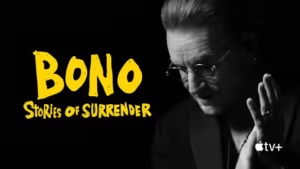
Bono: Stories of Surrender (A) – Complete Review – Zvideo
Paul David Hewson, widely known by his stage name Bono, is the frontman of the legendary Irish rock band U2. Over the decades, Bono has evolved from a young, passionate musician into a global icon—recognized not only for his music but also for his activism and humanitarian work. In 2022, Bono released his memoir, Surrender: 40 Songs, One Story, an introspective, poetic, and vivid account of his life. This work forms the basis of the one-man stage show titled Stories of Surrender, where Bono brings the book’s themes to life through storytelling, music, humor, and vulnerability.
Stories of Surrender (A), the first part of this immersive performance, represents much more than a mere musical showcase—it is a transformative narrative, encapsulating Bono’s personal and creative journey. This article explores the conceptual depth, structure, artistic choices, and emotional layers that define Stories of Surrender (A).
The Genesis of Stories of Surrender
From Memoir to Stage
Stories of Surrender emerged as a natural extension of Bono’s memoir. The book, structured around 40 U2 songs, serves as a reflection of pivotal moments in Bono’s life. These songs are not just milestones in his musical career—they are emotional waypoints that narrate love, loss, growth, and resilience.
Wanting to further explore these themes, Bono conceived a live performance that would blend music and monologue. Unlike traditional concerts, this was an intimate, theatrical event where storytelling was just as important as the songs themselves. The project was a collaborative effort involving director Willie Williams and musician Jacknife Lee, both of whom have long been associated with U2’s innovative stagecraft and production.
Format and Structure
A One-Man Show with Depth
In Stories of Surrender (A), Bono performs solo on stage, accompanied by a small musical ensemble that includes cello, piano, and harp. This stripped-down arrangement stands in stark contrast to U2’s high-octane stadium performances. Here, the focus shifts from spectacle to substance—from external grandeur to internal truth.
The show unfolds in a series of acts or “story chapters,” each linked to a particular U2 song. For instance, “Out of Control” serves as a metaphor for Bono’s youthful rage and rebellion, while “I Will Follow” delves into his complex relationship with his mother, Iris, who passed away when he was 14. Each song is reinterpreted—slower, more acoustic, and deeply emotional—to fit the introspective tone of the evening.
Themes and Emotional Landscape
Love and Loss
A prevailing theme in Stories of Surrender (A) is love in its many forms—familial, romantic, spiritual, and artistic. Bono frequently speaks of his wife, Ali Hewson, portraying her not only as a life partner but as his moral compass. Their enduring relationship becomes a central motif, with songs like “With or Without You” gaining new resonance when framed by the context of their shared history.
Loss is equally present. The early death of Bono’s mother shaped his emotional world and creative output. The performance allows him to revisit that trauma, not with bitterness, but with a sense of reconciliation. Bono recounts how music became his way of processing grief—a method of transforming pain into beauty.
Identity and Faith
Bono’s struggle with identity—both as a public figure and a private individual—is a recurring thread. He reflects on his dual life as a rock star and activist, often feeling the tension between ego and humility. His spiritual beliefs, rooted in Christianity but explored through a broader lens of humanism, permeate the narrative. Stories involving his prayer life, his views on grace, and his encounters with mortality add a philosophical layer to the performance.
Activism and Responsibility
The memoir and stage show both highlight Bono’s deep commitment to social justice. In Stories of Surrender (A), he recalls meetings with world leaders, his involvement in debt relief campaigns, and the founding of organizations like DATA (Debt, AIDS, Trade, Africa) and ONE. These anecdotes are delivered with a mixture of self-deprecating humor and earnest conviction, painting a nuanced picture of what it means to wield influence responsibly.
Musical Reinterpretations
Songs as Narratives
In Stories of Surrender (A), the songs are not performed as mere interludes—they are integral to the storytelling. Bono uses music as a narrative device, reshaping familiar tunes to align with the emotional tenor of each segment. The arrangements are sparse yet poignant, often relying on subtle instrumentation and vocal nuance rather than loud guitars or pulsating drums.
Examples include:
- “Sunday Bloody Sunday”: Stripped of its militaristic fervor, the song is transformed into a mournful reflection on violence and division.
- “Beautiful Day”: Rather than an anthem of optimism, it becomes a fragile expression of hope in the face of adversity.
- “Vertigo”: Reimagined as a tale of inner chaos and the seductive danger of fame.
These reinterpretations serve a dual purpose: they refresh the songs for longtime fans while inviting newcomers to engage with their meanings anew.
Artistic and Theatrical Choices
Minimalism and Intimacy
The stage design is intentionally minimal. A few props—a chair, a notebook, a bottle of water—create a setting that resembles a confessional more than a concert venue. The lighting shifts subtly to underscore emotional beats, while projected visuals occasionally add texture without overwhelming the performance.
This minimalist approach invites the audience into Bono’s inner world. There’s no hiding behind pyrotechnics or elaborate choreography. Instead, the focus is squarely on words, voice, and presence.
Humor and Humanity
Despite the heavy themes, Stories of Surrender (A) is also marked by levity and charm. Bono’s wit is sharp, his timing impeccable. He pokes fun at himself, at rock star clichés, even at his own activism. These moments of humor serve to disarm the audience, making the more serious reflections all the more powerful.
Critical Reception
Acclaim from Critics and Fans
The debut of Stories of Surrender (A) was met with widespread acclaim. Critics praised Bono’s vulnerability, his storytelling prowess, and the show’s emotional resonance. For fans, the experience was revelatory—a chance to see a rock legend in a completely new light.
Many reviews noted that while Bono has always been known for his stage presence, this performance revealed an entirely different dimension of his artistry. Gone was the bombastic frontman; in his place stood a seasoned storyteller, aware of his imperfections and unafraid to share them.
A New Benchmark for Memoir Performances
Stories of Surrender (A) has been hailed as a pioneering work in the genre of live memoir performances. It blurs the lines between concert, theater, and autobiography, setting a new standard for how musicians can engage with their audiences beyond traditional formats.
Cultural and Personal Impact
A Reintroduction of Bono
For many, Stories of Surrender (A) serves as a reintroduction to Bono. While he has long been a polarizing figure—admired by many, critiqued by some for his globalist ambitions—this show humanizes him. It offers insight into his fears, regrets, motivations, and dreams.
It’s also a timely reminder of the power of narrative in an age of noise. In a world saturated with quick takes and surface-level impressions, Bono’s deep dive into his life’s story is both refreshing and necessary.
Legacy and Longevity
This performance is more than a retrospective; it’s a reaffirmation of Bono’s enduring relevance. He is not content to rest on the laurels of U2’s success. Instead, he continues to evolve, pushing boundaries and exploring new modes of expression.
Stories of Surrender (A) adds a new chapter to his artistic legacy—one that will resonate for years to come, not just with music lovers but with anyone who appreciates the power of honest storytelling.
Conclusion
Stories of Surrender (A) is not simply a concert or a book reading—it is an experience that fuses narrative, music, and vulnerability into a powerful artistic statement. Through this deeply personal performance, Bono invites audiences into his journey of faith, fame, love, and loss. He challenges them to consider their own stories, their own surrenders, and ultimately, their own capacity for transformation.
What emerges is not a tale of triumph or perfection, but a story of surrender—of letting go, making peace, and finding strength in vulnerability. In sharing his truth, Bono encourages others to do the same. And in that act of sharing, art transcends entertainment—it becomes communion.







